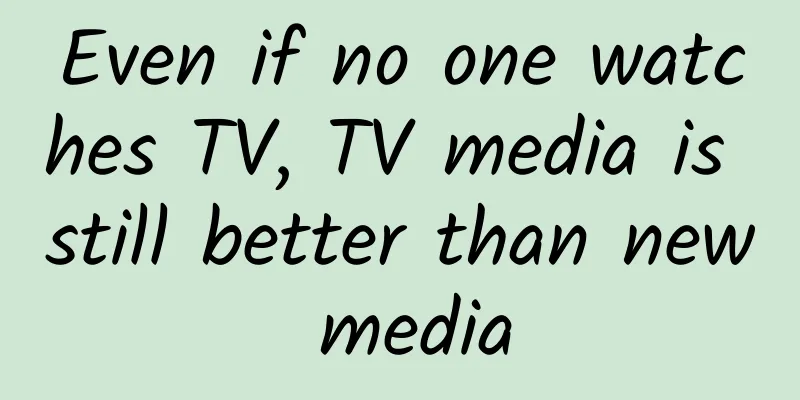Even if no one watches TV, TV media is still better than new media

|
TV has become a standard feature of the living room, but is it the core of your living room? When you get home from work, do you choose to turn on the TV to relax? When you turn on the TV and are bombarded with ads like "charge for five minutes, talk for two hours"; when you are faced with TV dramas interspersed with advertisements; when you are faced with the outrageous TV dramas and variety shows represented by Hunan Satellite TV; when you are faced with various ads embedded in TV dramas, you may immediately turn to your mobile phone, tablet, or computer. You will definitely have such a thought in your mind: why is traditional TV, which has been invaded by melodramatic TV dramas and advertisements, still alive? First of all, it is certain that fewer and fewer people watch TV. After tracking 4,654 foreign adult users, the Pew Research Center released the "2016 Social News Reading Habits" report in June this year, and the results showed that 62% of adults read news on social media. And the younger the age, the higher the proportion of getting news through social media. Among the 18-29 age group, the proportion of social media is 35%; while the older group (over 30 years old) still tends to get news through television channels, and the proportion of cable TV among the over 65 age group is as high as 43%. Let’s take a look at the domestic situation: According to iResearch’s survey data from January to March 2016, 60.8% of new media users used social media such as WeChat and Weibo as the main way to obtain news information in the past three months, while the proportion of traditional TV news was only 42.6%, and this proportion will continue to decline in the future. Why do people nowadays not like watching TV? If we have to sum it up in one word, it is "Interaction". Television news is a linear structure from top to bottom, and the information is transmitted to the audience through fixed channels (TV channels). However, there are a thousand Hamlets in the hearts of a thousand people. When we want to express our opinions on a piece of news, we can only communicate with the people around us, and we cannot form an information loop. On social media, everyone can comment on information and make opinions agree or collide with each other, which is impossible for traditional TV news. Moreover, social media is a network structure, everyone can be a disseminator and creator of information, and each dissemination point is not one-way, but radiates in the form of a hub. It is true that the rise of social media has had a huge impact on traditional television, but local TV stations represented by Hunan TV, and old and established radio stations such as CCTV, BBC and CNN have not declined due to the new media wave. Instead, they have thrived with this wave. Why is this? ■ Hunan Satellite TV: Creating its own new media After all, the audience cannot live in CCTV in a serious manner forever. The audience not only wants to get timely and comprehensive news information, but also wants to get happiness through screens of different sizes. In 2004, Hunan Satellite TV determined the positioning of "Happy China", and has surpassed other provincial satellite TV stations for many consecutive years, and even surpassed CCTV to rank first in the country. As the most representative provincial satellite TV station in the country, what is its biggest asset when facing new media? Copyright content. "Happy Camp", which was launched in July 1996, became Hunan Satellite TV's first work in the entertainment field. The endless variety shows such as "Day Day Up", "I Am a Singer", and "Where Are We Going, Dad?" always cater to the preferences of the current audience, thus gaining good ratings and discussion. In terms of TV series, after tasting the sweetness of "Dae Jang Geum" in 2005, Hunan Satellite TV began to try its own dramas after 2008, from "Ugly Wudi" to the later "Let's Watch Meteor Shower Together" and "Palace" series. In addition to entertainment, Hunan Satellite TV also has news programs such as "Metamorphosis". After controlling a wealth of copyrighted content, what will Hunan TV do in the face of the strong rise of new media? First of all, it is naturally to enhance the interaction with the audience. In December 2012, Hunan TV launched the Hula (Who? Now!) application, which is planned to become a bridge between home TV and mobile phones; in July 2013, Hula II was launched; in August 2015, the number of Hula users exceeded 20 million. However, this interaction did not bring much profit to Hunan TV, so Hunan TV carried out more diversified business operations and even cooperated with Alibaba to create the "Hi Tao Global" e-commerce website for women aged 18-35. Hunan Satellite TV has abundant high-quality resources, while new media has extensive communication channels, so the cooperation between the two is a natural outcome. Hunan Satellite TV has rapidly disseminated high-quality content through social media such as iQiyi and Sina Weibo, and has enhanced the distribution and influence of copyrighted content through various means such as hot topics and video preheating, and has also earned considerable profits through exclusive online broadcasting. However, Hunan TV is not satisfied with just using new media as a distribution channel for copyrighted content. It even wants to become a new media that can compete with Internet giants such as iQiyi, Youku, LeTV and Sohu. In April 2014, Mango TV was officially launched, marking the launch of Hunan TV's strategic plan for TV and Internet integration. It wields the sword of copyright and moves forward in a "Mango exclusive" way. With the completion of the deployment of the national CDN network, Hunan TV announced in May 2015 that it would no longer cooperate with other new media and build its own video brand. If you can get a ticket and airfare to Happy Camp, would you be willing to pay for a TV? Hunan Satellite TV also tried to diversify its new media layout with hardware. In June 2016, Mango TV received 1.5 billion yuan in round B financing and announced on August 8 that it would enter the smart TV system and hardware industry. With the slogan of "the ultimate thinking of TV people on TV", Mango TV launched the TV system MUI and announced cooperation with XGIMI Technology, Skyworth and other companies to jointly create hardware products such as Mango Box, Mango Projector and Mango TV. ■ China Central Television (CCTV) China Central Television, founded in 1958, also faces the challenge of new media. Like the BBC introduced below, it has taken the path of integration. Starting in 2012, CCTV launched three media platforms, Weibo, WeChat and client, under the brand of "CCTV News", forming a new media development pattern of "two microblogs and one client". Driven by continuous innovation in content and technology, the total number of new media users of "CCTV News" has exceeded 266 million, and a total of 73 new media mobile live broadcasts have been launched, with a total duration of 3,692 minutes, a total of 70.744 million viewers, and a reach of more than 319 million users. In addition, CCTV has more than 30 million fans on Facebook, second only to BBC News as an international mainstream media. Mutual integration in content Although CCTV has not opened a special citizen reporting platform, it has paid attention to and used UGC content at a very early stage. In 2007, when reporting on the severe snowstorm in the south, CCTV News Channel launched a video collection activity with the themes of "Fighting the Snowstorm" and "I Greet My Family for the New Year", advocating that everyone use mobile phones, DVs and other devices to record scenes and stories in the heavy snow. In 2013, during major events such as the Wenchuan earthquake, the Ningbo-Wenzhou high-speed rail accident, the "House Sister" incident, and the heavy rain in Beijing, CCTV gradually incorporated online posts, microblogs, and videos into the regular news production process. On August 18, 2014, General Secretary Xi Jinping’s important speech marked the beginning of the “media convergence era” in the history of Chinese news development. In order to promote the integrated development of traditional television news and social media, CCTV has set up an online news editorial department to achieve resource sharing among Weibo, WeChat, clients and news centers, independently plan original content based on key topics and dispatch all-media reporters to conduct interviews. Liang Jianzeng, former deputy director of CCTV News Center, believes that “two microblogs and one terminal” have effectively promoted the integrated operation of news production. On May 24, 2016, Weibo became CCTV's chief social media partner for Olympic coverage. During the upcoming Rio Olympics, the two sides will form a front-line self-media live broadcast team for the Olympics. CCTV Sports Channel's Olympic coverage team will share behind-the-scenes footage of the Olympic coverage on Weibo and guide channel viewers to participate in Weibo interaction; Weibo will enrich program content by providing user and content big data. The two sides will also jointly produce a self-media short video program to be broadcast on Weibo. Mutual integration in channels In 2013, CCTV-Variety and CCTV-Music launched new media technologies such as QR codes, allowing viewers to participate in channel interactions by scanning; in 2014, CCTV also tried out QR code interactions in the Spring Festival Gala and the World Cup, breaking through the one-way communication of program content and greatly improving the interactivity of the programs. In November 2012, CCTV News Center's official Weibo account "CCTV News" was officially launched; in April 2013, the WeChat public account "CCTV News" was launched; in May and July 2013, the Sohu client and independent client were launched respectively. With Weibo focusing on "first release", WeChat focusing on "interaction" and the client releasing "video", the single reporting form of TV programs has been effectively supplemented. The "two microblogs and one terminal" has also greatly enhanced the user stickiness of traditional programs. According to CCTV Sofres research, every 1% increase in Weibo discussion volume can lead to a 0.248% increase in the reach of TV programs and a 0.1% increase in ratings. CCTV has also gradually expanded from "two microblogs and one terminal" to "three microblogs and one terminal" (adding micro-videos on the original basis), effectively linking CCTV's high-quality content with various terminals, thereby allowing CCTV's new media and users to interact effectively. In addition, CCTV has upgraded the CCTV audio and video client, focusing on optimizing the audio-visual experience and launching the "HD Zone". At the same time, it has extended the "TV+" service with rich interactive functions and enriched the scene application with the "Listen to TV" audio function; it has aggregated CCTV's Weibo and WeChat clusters online to achieve sharing and coordinated promotion of social communication resources across the station. ■ British Broadcasting Corporation (BBC ) Founded in October 1922, the BBC has more than 20,000 employees and is undoubtedly the super fleet of the news industry, shuttling around the world. Like other mainstream television services in the world, this old news giant has also seen its ratings decline year by year. However, when we began to question whether television news was on its way out, it had already quietly begun to transform. Integration of content and social media In 2004, the BBC began using footage shot by tourists when reporting on the Indian Ocean tsunami; in April 2005, the BBC User Generated Content Hub (UGC Hub) was launched for trial operation. A small team of three people was responsible for filtering and screening information, photos and videos provided by the public, and digging out materials that could be used for news reports. Due to its outstanding performance in major breaking news such as the London subway bombings and the Buncefield oil depot explosion, the BBC officially launched the project in 2006, and it has become an important source of information for the BBC in its continuous evolution. With the rise of social media, users are no longer limited to traditional email and phone calls in submitting information to the BBC. To this end, the BBC has opened a "Have Your Say' entry on its official website. This column is similar to the CNN radio station's "iReport'" introduced below. In addition to traditional phone calls, text messages, emails, and official uploads, news can also be reported through chat software such as Twitter, WhatsApp and Telegram. While social media delivers timely and rich information to TV news, the BBC has also begun to introduce social elements into traditional programs to make them more interactive. The BBC World Service's "World Have Your Say" program discusses topics based on listener suggestions, and simultaneously launches an online forum on the BBC English News website to attract netizens to participate in the discussion. In addition, BBC Trending, which was launched on October 29, 2013, is also an important sign of the BBC's embrace of social media. Integration of channels and social media: BBC currently broadcasts news to the world in 30 languages. According to the BBC Annual Report 2015/16, the global visitor volume exceeded 320 million in 2015, which means that one in every 16 adults in the world visits BBC news services. It is estimated that the total number of global visits will exceed 500 million in 2022. Currently, BBC Breaking News has more than 24.2 million Twitter followers. With its excellent videos, BBC News' Facebook account has received 31.51 million "likes" and has become the largest news provider on Facebook. In fact, the BBC has long been aware of the impact of social media, and initially even wanted to build its own social platform. After failing to attract a large number of users, it quickly changed its strategy and encouraged programs and production staff to open accounts on popular social platforms including Twitter, Facebook, YouTube, Reddit, etc. The BBC also made full use of chat software such as WhatsApp, Mxit, BBM, etc. to report on the election, and used Viber to search for survivors. In addition, the BBC has also actively carried out application pre-installation work, such as Windows 7 in 2009, iPad launched in 2010, and the very popular smart TVs, we can all see the presence of the BBC. Since 2007, the BBC has proposed the product development strategies of "four screens" (i.e. TV, mobile phones, tablets and computers) and "mobile first" (producing mobile content first, then developing other versions). During the London Olympics, the BBC simultaneously opened 24 high-definition video live channels and broadcast more than 2,500 hours of Olympic events, allowing British audiences to watch live broadcasts of the Olympic Games anytime and anywhere on different media platforms such as digital TV, interactive TV, desktop computers, tablets, mobile phones, and BBC interactive players. Everyone can distribute and spread information on social media, which provides traditional TV media with more abundant first-hand news materials; when social media is full of rumors, traditional TV media has become a reliable information channel with its accumulated brand value; in terms of channels, new media provides more audiences for traditional TV media, and attracts more people to watch live broadcasts through social media and video website interactions. Even Hunan Satellite TV has tried to create new media on its own, and through hardware layout such as MUI, it may become the Apple of the TV industry in the future. As a winner of Toutiao's Qingyun Plan and Baijiahao's Bai+ Plan, the 2019 Baidu Digital Author of the Year, the Baijiahao's Most Popular Author in the Technology Field, the 2019 Sogou Technology and Culture Author, and the 2021 Baijiahao Quarterly Influential Creator, he has won many awards, including the 2013 Sohu Best Industry Media Person, the 2015 China New Media Entrepreneurship Competition Beijing Third Place, the 2015 Guangmang Experience Award, the 2015 China New Media Entrepreneurship Competition Finals Third Place, and the 2018 Baidu Dynamic Annual Powerful Celebrity. |
<<: Nokia phones are coming back: Why not learn from Japan and make good feature phones?
Recommend
Liang Jingye's Path to the Soul - Children's Sandplay Therapy 7 episodes
Liang Jingye's Path to the Soul: Children'...
Science and Technology News | The lightest magnesium isotope in history is discovered
【Today’s cover】 The blue water of Yamdrok Lake in...
CCTV reveals new "fast, accurate and ruthless" artillery shells, no flash of fire and no roar
Recently, CCTV's "Military Zero Distance...
What are the techniques for attracting fans for WeChat public accounts? Recommend some practical methods!
What are the techniques for attracting fans for W...
Collection | How to draw a home fire escape route map? Be prepared!
Source: National Emergency Broadcasting...
Sharing the application skills of six carriers of private domain traffic!
When we talk about private domain traffic , we ge...
Killer whales and dolphins: Stupid humans, come in and chat for five cents?
There are many happy elves living in the vast oce...
How many hairs do you have to lose every day to be at risk of baldness?
One minute with the doctor, the postures keep cha...
A new feature of Douyin information flow is launched, come and unlock new postures~
As short videos have become an important tool for...
A wave of positive patients has turned negative, they said these 9 things are important
So far, are there any lucky people who have passe...
When will the 2020 Jiujiang high school entrance examination results be announced? Four query methods announced
Today, the editor learned from the Municipal High...
I analyzed the data of 176 information flow advertisements and found that as long as these 4 points are achieved, it will be a good advertisement!
Recently, I often hear information flow advertise...
How hot is the sun? This probe has already touched it
During the Cold War between the United States and...
The media reported that India's unemployment rate is high and young people are keen on starting their own businesses. Netizens complained that this is following China's footsteps.
In January 2017, the number of employed people in...
Why is the annual salary of Gree’s Dong Mingzhu and Lenovo’s Yang Yuanqing 20 times different?
Why is the annual salary of Gree’s Dong Mingzhu a...









